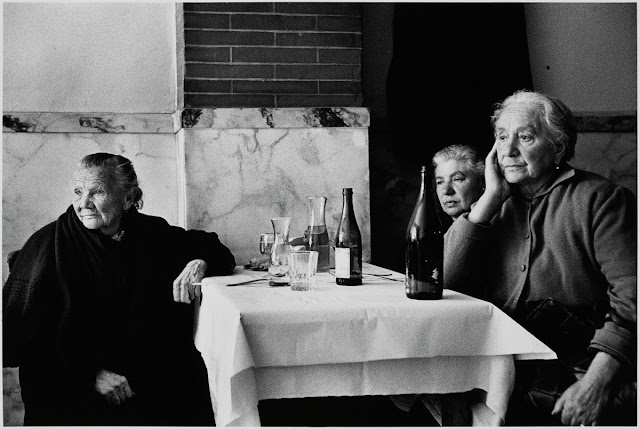 |
| Walker Evans Pantheon, Rome 1927 gelatin silver print National Gallery of Canada |
 |
| Lisette Model Rome 1953 gelatin silver print National Gallery of Canada |
 |
| Lisette Model Rome 1953 gelatin silver print National Gallery of Canada |
 |
| Lisette Model Rome 1953 gelatin silver print National Gallery of Canada |
"The photographer must become a servant to what is in front of her. Follow what the subject demands. This happens instinctively, unconsciously. The photographer draws on everything she has. What attracts her most. What she wants. Not good compositions. It's easy to make a lousy picture and have a good composition. –Like Krishnamurti said, you really have to pay attention. –Respond to the impact of what's coming toward you. That's what leads you. You don't make the pictures. They arrive. They make themselves."
"Years went by. I wasn't making photographs with any life in them. I was frantic. I'd poured my energy into the wrong things. Students. Teaching them to see. When I got the Guggenheim grant, I injured my leg, and ended up in the hospital. I should have listened to my astrologer. –You could be procrastinating, using illness as a way to avoid work or responsibility. –Later I used the grant to go to Rome. I didn't make vibrant pictures. Didn't someone say, What you do while you're waiting to do what you want to do, is what you do. I had become a teacher."
– from Lisette Model: A Narrative Autobiography by Eugenia Parry, edited and designed by Manfred Heiting (Steidl, 2009)
 |
| Lisette Model Rome 1953 gelatin silver print National Gallery of Canada |
 |
| Lisette Model Rome 1953 gelatin silver print National Gallery of Canada |
 |
| Lisette Model Rome 1953 gelatin silver print National Gallery of Canada |
 |
| Lisette Model Rome 1953 gelatin silver print National Gallery of Canada |
"In Paris, I had to be taught to notice light. I had an epiphany when I realized that nuances of changing light gave the most ordinary things entirely new temperaments. Under natural conditions, with no artificial light, we would spend half our lives with the god of light, half with the forces of darkness. These changes are the most important conditions for the development of plants, animals. They also determine our human understanding of the world. That's what I wrote in my teaching notebooks."
"I taught my students about the emotional power of light by positioning a beam on the same object from different vantage points to show how it could become monstrous, terrifying, angelic, by turns. The students never forgot this exercise. It was more than about seeing, it was a lesson in feeling. Funny, how you end up teaching others what you completely ignored yourself."
– from Lisette Model: A Narrative Autobiography by Eugenia Parry, edited and designed by Manfred Heiting (Steidl, 2009)
 |
| Walter Curtin Rome 1965 gelatin silver print National Gallery of Canada |
 |
| Roloff Beny Fontana della Tartarughe, Piazza Mattei, Rome before 1966 gelatin silver print National Gallery of Canada |
 |
| Geoffrey James Villa Medici, Rome Alley from the Pincio Wall to the Courtyard Garden 1984 gelatin silver print National Gallery of Canada |
 |
| Geoffrey James Villa Medici, Rome The Loggia 1984 gelatin silver print National Gallery of Canada |
 |
| Geoffrey James Villa Medici, Rome Niobe and her Children 1984 gelatin silver print National Gallery of Canada |
 |
| Geoffrey James Forum, Rome 1989 gelatin silver print National Gallery of Canada |